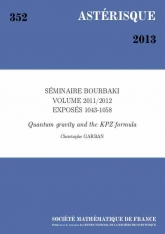Exposé Bourbaki 1052 : Gravité quantique et relation KPZ d'après Duplantier-Sheffield
Exposé Bourbaki 1052 : Quantum gravity and the KPZ formula after Duplantier-Sheffield

- Consulter un extrait
- Année : 2013
- Tome : 352
- Format : Électronique
- Langue de l'ouvrage :
Anglais - Class. Math. : 60C05, 60F17, 60-02, 05C10, 05C80, 82B20, 82B05, 82B27
- Pages : 315-354
L'étude de modèles de mécanique statistique en dimension deux à leur point critique est un problème en général très difficile. Dans les années 80, trois physiciens, Knizhnik, Polyakov et Zamolodchikov (KPZ) ont développé une approche originale pour comprendre la géométrie de ces modèles critiques. Parmi eux, on trouve entre autres la marche aléatoire, la percolation, le modèle d'Ising. L'idée sous-jacente est d'étudier ces modèles en deux temps de la façon suivante :
- Dans un premier temps, on étudie le modèle non pas sur un réseau régulier du plan (tel que $\mathbb{Z}^2$ par exemple), mais sur un "réseau aléatoire" planaire. Pour la percolation, le bon modèle aléatoire de réseau correspond aux "cartes planaires uniformes" étudiées notamment par Le Gall et Miermont. C'est ce qu'on appelle étudier le modèle du côté gravité quantique.
- On se ramène ensuite au cas euclidien via la célèbre relation de KPZ qui donne une correspondance très précise entre les propriétés géométriques du côté gravité quantique et leurs analogues du côté euclidien.
La nature de cette correspondance est restée longtemps assez mystérieuse. Nous expliquerons en quoi les travaux de Duplantier et Sheffield permettent d'interpréter cette correspondance comme une uniformisation du réseau aléatoire vu comme une surface de Riemann.

